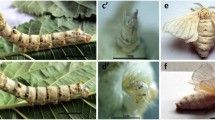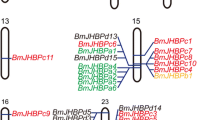Abstract
Doublesex-mab3-related transcription factor (DMRT) genes encode a family of transcription factors that are conserved among phyla. DMRTs are related to sex determination or differentiation. However, several DMRTs, known as DMRTAs, are irrelevant to sex determination and sexual differentiation, but play an important role in neurogenesis in diverse animal species. In this study, we identified a Bombyx ortholog of an arthropod-specific DMRT, dmrt99B (designated Bmdmrt99B), and characterized its function. Bmdmrt99B was preferentially expressed in the ovary and brain of larvae. The food-seeking ability of the larvae of two Bmdmrt99B mutant strains was disrupted, which decreased their food intake. The Bmdmrt99B mutant larvae also showed abnormal scattering behavior. Moreover, mutant adult males responded to the female sex pheromone but could not localize its source. Our findings suggest that the neurogenetic function of DMRT is conserved among insect species and that DMRT plays an important role in the regulation of normal behaviors in insects.






Similar content being viewed by others
References
Andersson LS, Larhammar M, Memic F et al (2012) Mutations in DMRT3 affect locomotion in horses and spinal circuit function in mice. Nature 488:642–646
Balciuniene J, Bardwell VJ, Zarkower D (2006) Mice mutant in the DM domain gene Dmrt4 are viable and fertile but have polyovular follicles. Mol Cell Biol 26:8984–8991
Burtis KC, Baker BS (1989) Drosophila doublesex gene controls somatic sexual differentiation by producing alternatively spliced mRNAs encoding related sex-specific polypeptides. Cell 56:997–1010
Butenandt A, Beckmann R, Stamm D, Hecker E (1959) Über den sexuallockstoff des seidenspinners Bombyx mori. Reindarstellung und konstitution. Z Nat 14:283–284
Chen P, Xu SL, Zhou W, Guo XG, Wang CL, Wang DL, Zhao YL (2014) Cloning and expression analysis of a transformer gene in Daphnia pulex during different reproduction stages. Anim Reprod Sci 146:227–237
Chen CJ, Shikina S, Chen WJ, Chung YJ, Chiu YL, Bertrand JA, Lee YH, Chang CF (2016) A novel female-specific and sexual reproduction-associated dmrt gene discovered in the stony coral. Euphyllia ancora. Biol Reprod 94:40
De Clercq S, Keruzore M, Desmaris E et al (2016) DMRT5 together with DMRT3 directly controls hippocampus development and neocortical area map formation. Cereb Cortex 28:493–509
Fontana JR, Crews ST (2012) Transcriptome analysis of Drosophila CNS midline cells reveals diverse peptidergic properties and a role for castor in neuronal differentiation. Dev Biol 372:131–142
Fujita N, Nagata Y, Nishiuchi T, Sato M, Iwami M, Kiya T (2013) Visualization of neural activity in insect brains using a conserved immediate early gene, Hr38. Curr Biol 23:2063–2070
Graf M, Teo Qi-Wen ER, Sarusie MV, Rajaei F, Winkler C (2015) Dmrt5 controls corticotrope and gonadotrope differentiation in the zebrafish pituitary. Mol Endocrinol 29:187–199
Guan G, Kobayashi T, Nagahama Y (2000) Sexually dimorphic expression of two types of DM (Doublesex/Mab-3)-domain genes in a teleost fish, the Tilapia (Oreochromis niloticus). Biochem Biophys Res Commun 272:662–666
Hamamura Y, Hayashiya K, Naito K, Matsuura K, Nishida J (1962) Food selection by silkworm larvae. Nature 194:754–755
Henry GL, Davis FP, Picard S, Eddy SR (2012) Cell type-specific genomics of Drosophila neurons. Nucleic Acids Res 40:9691–9704
Hodgkin J (2002) The remarkable ubiquity of DM domain factors as regulators of sexual phenotype: ancestry or aptitude? Genes Dev 16:2322–2326
Huang X, Hong CS, O’Donnell M, Saint-Jeannet JP (2005) The doublesex-related gene, XDmrt4, is required for neurogenesis in the olfactory system. Proc Natl Acad Sci USA 102:11349–11354
Hwang WY, Fu Y, Reyon D, Maeder ML, Tsai SQ, Sander JD, Peterson RT, Joanna Yeh JR, Joung JK (2013) Efficient in vivo genome editing using RNA-guided nucleases. Nat Biotechnol 31:227–229
Kaissling KE, Kasang G, Bestmann J, Stransky W, Vostrowsky O (1978) A new pheromone of the silkworm moth Bombyx mori. Sci Nat 65:382–384
Kanzaki R, Sugi N, Shibuya T (1992) Self-generated zigzag turning of Bombyx mori males during pheromone-mediated upwind walking. Zool Sci 9:515–527
Kato Y, Kobayashi K, Oda S, Colbourn JK, Tatarazako N, Watanabe H, Iguchi T (2008) Molecular cloning and sexually dimorphic expression of DM-domain genes in Daphnia magna. Genomics 91:94–101
Kato Y, Kobayashi K, Oda S, Tatarazako N, Watanabe H, Iguchi T (2010) Sequence divergence and expression of a transformer gene in the branchiopod crustacean, Daphnia magna. Genomics 95:160–165
Kikkawa T, Obayashi T, Takahashi M, Fukuzaki-Dohi U, Numayama-Tsuruta K, Osumi N (2013) Dmrta1 regulates proneural gene expression downstream of Pax6 in the mammalian telencephalon. Genes Cells 18:636–649
Koike Y, Mita K, Suzuki MG, Maeda S, Abe H, Osoegawa K, deJong PJ, Shimada T (2003) Genomic sequence of a 320-kb segment of the Z chromosome of Bombyx mori containing a kettin ortholog. Mol Genet Genom 269:137–149
Kondo M, Froschauer A, Kitano A et al (2002) Molecular cloning and characterization of DMRT genes from the medaka Oryzias latipes and the platyfish Xiphophorus maculatus. Gene 295:213–222
Kopp A (2012) Dmrt genes in the development and evolution of sexual dimorphism. Trends Genet 28:175–184
Ma S, Chang J, Wang X et al (2014) CRISPR/Cas9 mediated multiplex genome editing and heritable mutagenesis of BmKu70 in Bombyx mori. Sci Rep 4:4489
Mine S, Sumitani M, Aoki F, Hatakeyama M, Suzuki MG (2017) Identification and functional characterization of the sex-determining gene doublesex in the sawfly, Athalia rosae (Hymenoptera). Appl Entomol Zool 52:497–509
Mori M (1982) n-Hexacosanol and noctacosanol: feeding stimulants for larvae of the silkworm, Bombyx mori. J Insect Physiol 28:969–973
Muralidharan B, Keruzore M, Pradhan SJ et al (2017) Dmrt5, a novel neurogenic factor, reciprocally regulates Lhx2 to control the neuron-glia cell fate switch in the developing hippocampus. J Neurosci 37:11245–11254
Nagata S, Nagasawa H (2006) Effects of diet-deprivation and physical stimulation on the feeding behavior of the larvae of the silkworm, Bombyx mori. J Insect Physiol 52:807–815
Namiki S, Iwabuchi S, Pansopha Kono P, Kanzaki R (2014) Information flow through neural circuits for pheromone orientation. Nat Commun 5:5919
Parlier D, Moers V, Van Campenhout C et al (2013) The Xenopus doublesex-related gene Dmrt5 is required for olfactory placode neurogenesis. Dev Biol 373:39–52
Picard MA, Cosseau C, Mouahid G, Duval D, Grunau C, Toulza È, Allienne JF, Boissier J (2015) The roles of Dmrt (double sex/male-abnormal-3 related transcription factor) genes in sex determination and differentiation mechanisms: ubiquity and diversity across the animal kingdom. C R Biol 338:451–462
Pomerantz AF, Hoy MA, Kawahara AY (2015) Molecular characterization and evolutionary insights into potential sex-determination genes in the western orchard predatory mite Metaseiulus occidentalis (Chelicerata: Arachnida: Acari: Phytoseiidae). J Biomol Struct Dyn 33:1239–1253
Raymond CS, Shamu CE, Shen MM, Seifert KJ, Hirsch B, Hodgkin J, Zarkower D (1998) Evidence for evolutionary conservation of sex-determining genes. Nature 391:691–695
Sakurai T, Nakagawa T, Mitsuno H, Mori H, Endo Y, Tanoue S, Yasukochi Y, Touhara K, Nishioka T (2004) Identification and functional characterization of a sex pheromone receptor in the silkmoth Bombyx mori. Proc Natl Acad Sci USA 101:16653–16658
Sakurai T, Mitsuno H, Haupt SS et al (2011) A single sex pheromone receptor determines chemical response specificity of sexual behavior in the silkmoth Bombyx mori. PLoS Genet 7:e1002115
Sakurai T, Namiki S, Kanzaki R (2014) Molecular and neural mechanisms of sex pheromone reception and processing in the silkmoth Bombyx mori. Front Physiol 5:125
Sakurai T, Mitsuno H, Mikami A, Uchino K, Tabuchi M, Zhang F, Sezutsu H, Kanzaki R (2015) Targeted disruption of a single sex pheromone receptor gene completely abolishes in vivo pheromone response in the silkmoth. Sci Rep 5:11001
Saulnier A, Keruzore M, De Clercq S et al (2013) The doublesex homolog Dmrt5 is required for the development of the caudomedial cerebral cortex in mammals. Cereb Cortex 23:2552–2567
Sumioka H, Kuroda S, Yoshitake N (1982) Feed efficiency and expression of several characters of the silkworm, Bombyx mori, under the restricted feeding. J Seric Sci 51:415–419
Suzuki MG, Suzuki K, Aoki F, Ajimura M (2012) Effect of RNAi-mediated knockdown of the Bombyx mori transformer-2 gene on the sex-specific splicing of Bmdsx pre-mRNA. Int J Dev Biol 56:693–699
Tabuchi M, Sakurai T, Mitsuno H et al (2013) Pheromone responsiveness threshold depends on temporal integration by antennal lobe projection neurons. Proc Natl Acad Sci USA 110:15455–15460
Tanaka K, Uda Y, Ono Y, Nakagawa T, Suwa M, Yamaoka R, Touhara K (2009) Highly selective tuning of a silkworm olfactory receptor to a key mulberry leaf volatile. Curr Biol 19:881–890
Tresser J, Chiba S, Veeman M, El-Nachef D, Newman-Smith E, Horie T, Tsuda M, Smith WC (2010) doublesex/mab3 related-1 (dmrt1) is essential for development of anterior neural plate derivatives in Ciona. Development 137:2197–2203
Urquhart JE, Beaman G, Byers H et al (2016) DMRTA2 (DMRT5) is mutated in a novel cortical brain malformation. Clin Genet 89:724–727
Wang Y, Li Z, Xu J, Zeng B, Ling L, You L, Chen Y, Huang Y, Tan A (2013) The CRISPR/Cas system mediates efficient genome engineering in Bombyx mori. Cell Res 23:1414–1416
Wei W, Xin H, Roy B, Dai J, Miao Y, Gao G (2014) Heritable genome editing with CRISPR/Cas9 in the silkworm, Bombyx mori. PLoS One 9:e101210
Wen S, Dauwalder B, McGuffin ME, Villinski J, Mattox W (2001) Analysis of three doublesex related genes suggests that they play roles in sexual differentiation. A Dros Res Conf 42:656B
Wexler JR, Plachetzki DC, Kopp A (2014) Pan-metazoan phylogeny of the DMRT gene family: a framework for functional studies. Dev Genes Evol 224:175–181
Yoshimoto S, Okada E, Umemoto H et al (2008) A W-linked DM-domain gene, DM-W, participates in primary ovary development in Xenopus laevis. Proc Natl Acad Sci USA 105:2469–2474
Yoshizawa A, Nakahara Y, Izawa T, Ishitani T, Tsutsumi M, Kuroiwa A, Itoh M, Kikuchi Y (2011) Zebrafish Dmrta2 regulates neurogenesis in the telencephalon. Genes Cells 16:1097–1109
Yu YQ, Ma WM, Zeng QG, Qian YQ, Yang JS, Yang WJ (2014) Molecular cloning and sexually dimorphic expression of two Dmrt genes in the giant freshwater prawn, Macrobrachium rosenbergii. Agric Res 3:181–191
Zhang EF, Qiu GF (2010) A novel Dmrt gene is specifically expressed in the testis of Chinese mitten crab, Eriocheir sinensis. Dev Genes Evol 220:151–159
Zhang Z, Aslam AF, Liu X, Li M, Huang Y, Tan A (2015) Functional analysis of Bombyx Wnt1 during embryogenesis using the CRISPR/Cas9 system. J Insect Physiol 79:73–79
Zwarts L, Vanden Broeck L, Cappuyns E, Ayroles JF, Magwire MM, Vulsteke V, Clements J, Mackay TF, Callaerts P (2015) The genetic basis of natural variation in mushroom body size in Drosophila melanogaster. Nat Commun 6:10115
Acknowledgements
This work was supported by a Grant-in-Aid for Scientific Research (B), 17H03940, 2017.
Author information
Authors and Affiliations
Corresponding author
Electronic supplementary material
Below is the link to the electronic supplementary material.
Supplementary material 1 (MP4 4102 kb)
Supplementary material 2 (MP4 32800 kb)
Rights and permissions
About this article
Cite this article
Kasahara, R., Aoki, F. & Suzuki, M.G. Deficiency in dmrt99B ortholog causes behavioral abnormalities in the silkworm, Bombyx mori. Appl Entomol Zool 53, 381–393 (2018). https://doi.org/10.1007/s13355-018-0569-5
Received:
Accepted:
Published:
Issue Date:
DOI: https://doi.org/10.1007/s13355-018-0569-5




